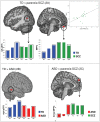Schizophrenia and autism as contrasting minds: neural evidence for the hypo-hyper-intentionality hypothesis
- PMID: 25210055
- PMCID: PMC4266299
- DOI: 10.1093/schbul/sbu124
Schizophrenia and autism as contrasting minds: neural evidence for the hypo-hyper-intentionality hypothesis
Abstract
Both schizophrenia (SCZ) and autism spectrum disorder (ASD) are characterized by mentalizing problems and associated neural dysfunction of the social brain. However, the deficits in mental state attribution are somehow opposed: Whereas patients with SCZ tend to over-attribute intentions to agents and physical events ("hyper-intentionality"), patients with autism treat people as devoid of intentions ("hypo-intentionality"). Here we aimed to investigate whether this hypo-hyper-intentionality hypothesis can be supported by neural evidence during a mentalizing task. Using functional magnetic resonance imaging (fMRI), we investigated the neural responses and functional connectivity during reading others intention. Scanning was performed in 23 individuals with ASD, 18 with paranoid SCZ and 23 gender and IQ matched control subjects. Both clinical groups showed reduced brain activation compared to controls for the contrast intentional vs physical information processing in left posterior superior temporal sulcus (pSTS) and ventral medial prefrontal cortex (vMPFC) for SCZ, and right pSTS in ASD. As predicted, these effects were caused in a group specific way: Relative increased activation for physical information processing in SCZ that was also correlated with positive PANNS score and relative decreased activation for intentional information processing in ASD. Additionally, we could demonstrate opposed connectivity patterns between the right pSTS and vMPFC in the clinical groups, ie, increased for SCZ, decreased for ASD. These findings represent opposed neural signatures in key regions of the social brain as predicted by the hyper-hypo-intentionality hypothesis.
Keywords: MPFC; autism; intention; mentalising; pSTS; schizophrenia.
© The Author 2014. Published by Oxford University Press on behalf of the Maryland Psychiatric Research Center. All rights reserved. For permissions, please email: journals.permissions@oup.com.
Figures



Similar articles
-
Neural bases for impaired social cognition in schizophrenia and autism spectrum disorders.Schizophr Res. 2008 Feb;99(1-3):164-75. doi: 10.1016/j.schres.2007.10.024. Epub 2007 Nov 28. Schizophr Res. 2008. PMID: 18053686 Free PMC article.
-
Neural processing of intentional biological motion in unaffected siblings of children with autism spectrum disorder: an fMRI study.Brain Cogn. 2013 Dec;83(3):297-306. doi: 10.1016/j.bandc.2013.09.007. Epub 2013 Oct 12. Brain Cogn. 2013. PMID: 24128657 Free PMC article.
-
Hyper- and Hypomentalizing in Patients with First-Episode Schizophrenia: fMRI and Behavioral Studies.Schizophr Bull. 2019 Mar 7;45(2):377-385. doi: 10.1093/schbul/sby027. Schizophr Bull. 2019. PMID: 29534245 Free PMC article.
-
Research review: Constraining heterogeneity: the social brain and its development in autism spectrum disorder.J Child Psychol Psychiatry. 2011 Jun;52(6):631-44. doi: 10.1111/j.1469-7610.2010.02349.x. Epub 2011 Jan 19. J Child Psychol Psychiatry. 2011. PMID: 21244421 Free PMC article. Review.
-
[Social cognition in schizophrenia and autism spectrum disorder: Points of convergence and functional differences].Encephale. 2018 Dec;44(6):523-537. doi: 10.1016/j.encep.2018.03.004. Epub 2018 Aug 16. Encephale. 2018. PMID: 30122298 Review. French.
Cited by
-
Preserved implicit mentalizing in schizophrenia despite poor explicit performance: evidence from eye tracking.Sci Rep. 2016 Oct 5;6:34728. doi: 10.1038/srep34728. Sci Rep. 2016. PMID: 27703225 Free PMC article.
-
Aberrant effective connectivity is associated with positive symptoms in first-episode schizophrenia.Neuroimage Clin. 2020;28:102444. doi: 10.1016/j.nicl.2020.102444. Epub 2020 Sep 22. Neuroimage Clin. 2020. PMID: 33039973 Free PMC article.
-
Social-cognitive brain function and connectivity during visual perspective-taking in autism and schizophrenia.Schizophr Res. 2017 May;183:102-109. doi: 10.1016/j.schres.2017.03.009. Epub 2017 Mar 11. Schizophr Res. 2017. PMID: 28291690 Free PMC article.
-
Task-based functional neural correlates of social cognition across autism and schizophrenia spectrum disorders.Mol Autism. 2024 Sep 4;15(1):37. doi: 10.1186/s13229-024-00615-3. Mol Autism. 2024. PMID: 39252047 Free PMC article.
-
Differences in frontotemporal dysfunction during social and non-social cognition tasks between patients with autism spectrum disorder and schizophrenia.Sci Rep. 2018 Feb 14;8(1):3014. doi: 10.1038/s41598-018-21379-w. Sci Rep. 2018. PMID: 29445197 Free PMC article.
References
-
- Lord C, Cook EH, Leventhal BL, Amaral DG.Autism spectrum disorders.Neuron.2000;28:355–363. - PubMed
-
- Crow TJ.The two-syndrome concept: origins and current status.Schizophr Bull.1985;11:471–486. - PubMed
-
- Crespi B, Badcock C.Psychosis and autism as diametrical disorders of the social brain.Behav Brain Sci.2008;31:241–261 - PubMed
-
- Adolphs R.Cognitive neuroscience of human social behaviour.Nat Rev Neurosci.2003;4:165–178. - PubMed
-
- Ciaramidaro A Adenzato M Enrici I, et al. . The intentional network: how the brain reads varieties of intentions.Neuropsychologia.2007;45:3105–3113. - PubMed
Publication types
MeSH terms
LinkOut - more resources
Full Text Sources
Other Literature Sources
Research Materials

